What does the VLIZ Marine Data Center do?
The VLIZ data center is a national and international point of contact for quality and reliable marine and estuarine data. The VLIZ Marine Data Center (VMDC) provides services, technologies, tools, training and support to scientists, policy, blue economy and citizens. Data is made accessible in an efficient and open manner. The VMDC is accredited as an IODE National Oceanographic Data Center.
The VLIZ Marine Data Center has six core activities, centralized around "open science".
FAIR data management
FAIR data management means that the data is Findable, Accessible, Interoperable and Reusable. Specifically, the data center applies this as:
- Documenting data: describing datasets and providing them with the necessary metadata
- Integrating data: collecting dispersed data and incorporating it into recognized data systems
- Archiving data: storing data for future generations
- Distributing and sharing data: responding to data requests and publishing data
- Improve standardization and cooperation with other data (systems)
- Open configuration settings
- Computer screen with Marine Regions information

Development of derived data products
Data products such as data apps, analysis techniques, GIS maps, data visualization and contributions to open source projects and species registries are being developed and add value to marine research groups and marine policy.
Data network
VLIZ data center actively participates in regional and international data networks and establishes strategic cross-discipline networks.
Promoting and using open science
The data center promotes, uses, and ensures that Open Science data and data systems are FAIR. It will also implement technologies that promote Open Science, such as LOD, meaning "Linked Open Data," or the semantic web.
Data literacy training and support
The data center will provide training and support through improving data literacy through manuals, tutorials and guidelines.
Management of international e-infrastructures
The data center manages international e-infrastructures such as:
LifeWatch: Virtual laboratory for biodiversity research, consisting of observation stations, databases, digital services and tools to develop models, spread across Europe
EMODnet: The European Marine Observation and Data network consists of organizations working together to observe the sea, process data and make the information freely available.
WoRMS: The World Register of Marine Species aims to produce a complete list of marine organisms.
EurOBIS: European node of the international Ocean Biodiversity Information System, an online marine biogeographic database that centralizes the now scattered information of all living marine creatures.
Marine Regions: A standard list of marine geographic information of areas and boundaries at sea.
Scheldemonitor: A Flemish-Dutch knowledge portal on research and monitoring of the Scheldt estuary
